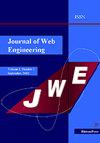Towards Adaptive Continuous Trajectory Clustering Over a Distributed Web Data Stream
IF 0.7
4区 计算机科学
Q4 COMPUTER SCIENCE, SOFTWARE ENGINEERING
引用次数: 0
Abstract
With the popularity of modern mobile devices and GPS technology, big web stream data with location are continuously generated and collected. The sequential positions form a trajectory, and the clustering analysis on trajectories is beneficial to a wide range of applications, e.g., route recommendation. In the past decades, extensive efforts have been made to improve the efficiency of static trajectory clustering. However, trajectory stream data is received incrementally, and the continuous trajectory clustering inevitably faces the following two problems: (1) physical structure design for trajectory representation leads to severe space overhead, and (2) dynamic maintenance of trajectory semantics and its retrieval structure brings intensive computation. To overcome the above problems, an adaptive continuous trajectory clustering framework (ACTOR) is proposed in this paper. Overall, it covers three key components: (1) Simplifier represents trajectory with a well-designed PT structure. (2) Partitioner utilizes a hexagonal-based indexing strategy to enhance the local computational efficiency. (3) Executor accommodates an adaptive selection of P-clustering and R-clustering approaches according to the ROC (rate of change) matrix. Empirical studies on real-world data validate the usefulness of our proposal and prove the huge advantage of our approach over available solutions in the literature.分布式Web数据流上的自适应连续轨迹聚类
随着现代移动设备和GPS技术的普及,带有位置的大网络流数据不断生成和收集。顺序位置形成轨迹,并且对轨迹的聚类分析有利于广泛的应用,例如路线推荐。在过去的几十年里,人们已经做出了广泛的努力来提高静态轨迹聚类的效率。然而,轨迹流数据是增量接收的,连续轨迹聚类不可避免地面临以下两个问题:(1)轨迹表示的物理结构设计导致了严重的空间开销;(2)轨迹语义及其检索结构的动态维护带来了密集的计算。针对上述问题,本文提出了一种自适应连续轨迹聚类框架(ACTOR)。总体而言,它涵盖了三个关键组成部分:(1)Simplifier用精心设计的PT结构表示轨迹。(2) Partitioner利用基于六边形的索引策略来提高局部计算效率。(3) 执行器根据ROC(变化率)矩阵适应P聚类和R聚类方法的自适应选择。对真实世界数据的实证研究验证了我们的建议的有用性,并证明了我们的方法相对于文献中可用解决方案的巨大优势。
本文章由计算机程序翻译,如有差异,请以英文原文为准。
求助全文
约1分钟内获得全文
求助全文
来源期刊

Journal of Web Engineering
工程技术-计算机:理论方法
CiteScore
1.80
自引率
12.50%
发文量
62
审稿时长
9 months
期刊介绍:
The World Wide Web and its associated technologies have become a major implementation and delivery platform for a large variety of applications, ranging from simple institutional information Web sites to sophisticated supply-chain management systems, financial applications, e-government, distance learning, and entertainment, among others. Such applications, in addition to their intrinsic functionality, also exhibit the more complex behavior of distributed applications.
 求助内容:
求助内容: 应助结果提醒方式:
应助结果提醒方式:


